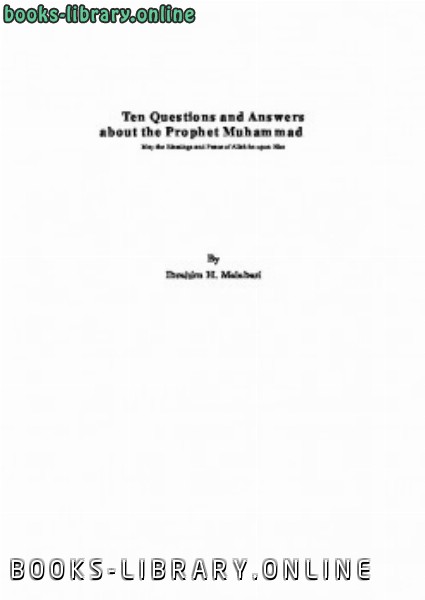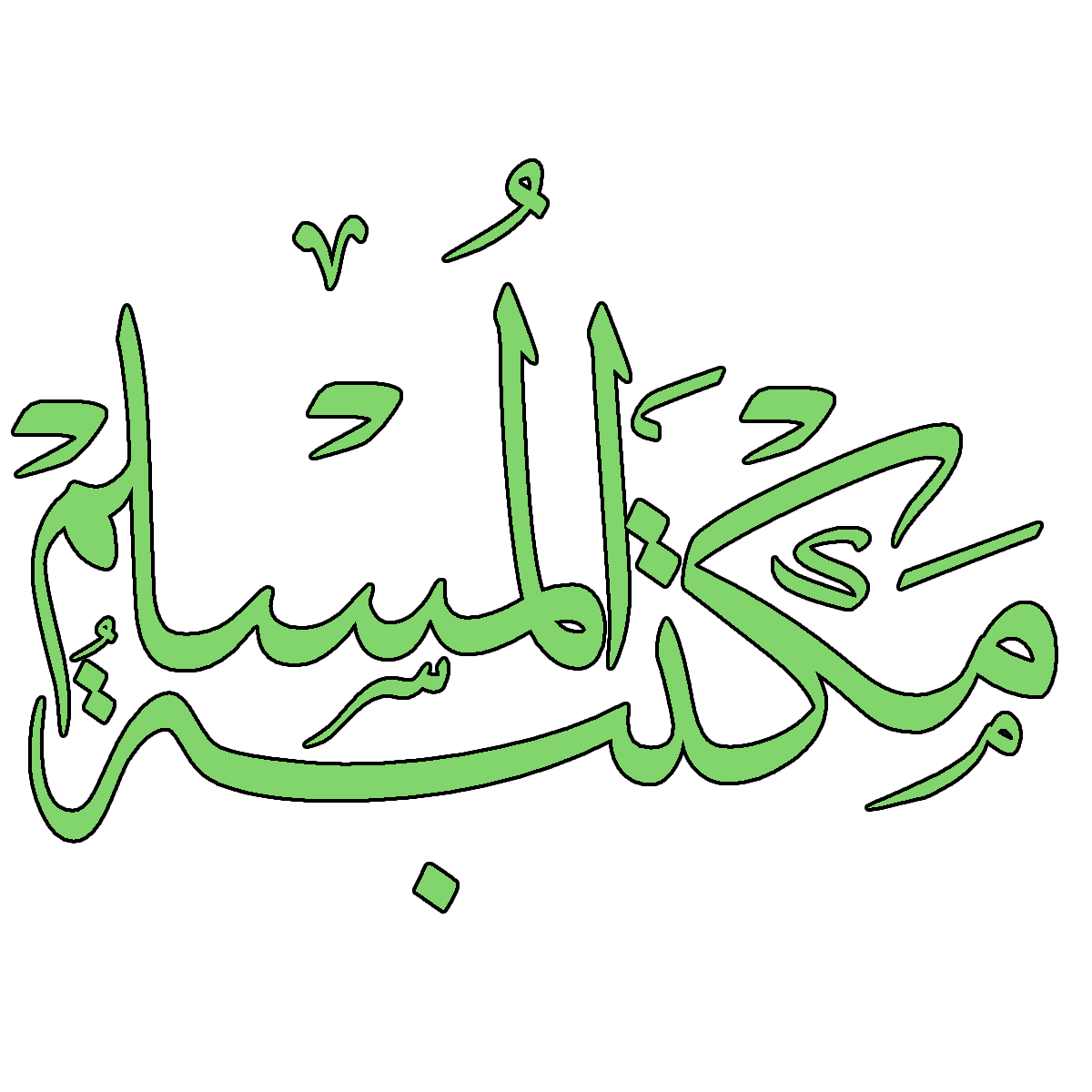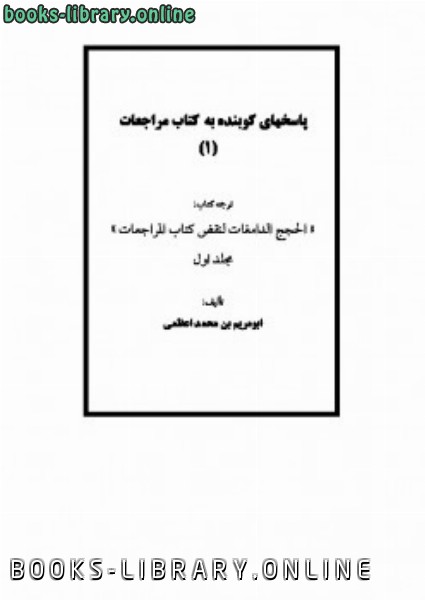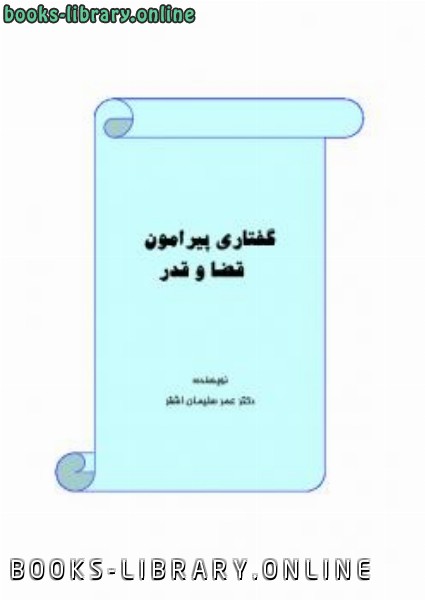كتاب Ten Questions and Answers about the Prophet Muhammad
Whenever Prophet Muhammad’s name emerges, the image in many people’s minds is a man with many wives. For Muslims, his multiple marriages had meaning and immense implications for Islam, and by extension, the history of the world. Needless to say, the issue remains controversial, and as such, any study of the matter requires an objective approach. Therefore we will endeavour to tackle this topic by being as objective as possible. The Prophet Muhammad was driven by the goal to ensure that his mission as the Messenger of God was fulfilled and to establish a society based on God’s commands, and not his own. In order to achieve this goal, he did everything that was humanly possible: he forged relations with the various tribes of Arabia, concluded peace treaties with his sworn enemies and kept relations with the heads of various tribes, nations and religions. Taken together his marriages was one way by Ten Questions and Answers about the Prophet Muhammad which he fostered relationships with various influential tribes. If one were to view the marriages of the Prophet from this context, the motivating factors behind his marriages become clear. It would be very simplistic and incorrect to view his marriages as being merely for lustful ends. Let us now briefly examine the context of each one of his marriages to see whether this was the case. From the outset, it is of ultimate importance to note that, except for one of his wives, all of his eleven wives were widowed or divorced. Most were in fact widowed. His first marriage was to a widow named Khadijah, who had been married twice and whom he married when she was forty years old and he was twenty five. She was the first woman to embrace Islam. She provided great consolation to him throughout his life and he continued to remember her in his later years as his most beloved wife. He stayed with her faithfully for 25 years until her death, at which time he was 50 years old, and she was 65 years old. A brief book regarding Peace be upon him , Some nonMuslim westerners have been wondering what it is that Prophet Muhammad Peace be upon him presented to humanity, particularly after the defamation of his honorable character by western media, and we deem it our duty to answer the questions regarding what our Prophet gave to humanity and the world.إبراهيم حسن مالاباري - ❰ له مجموعة من الإنجازات والمؤلفات أبرزها ❞ Ten Questions and Answers about the Prophet Muhammad ❝ ❱
من كتب إسلامية بلغات أخرى - مكتبة كتب إسلامية.

قراءة كتاب Ten Questions and Answers about the Prophet Muhammad أونلاين
معلومات عن كتاب Ten Questions and Answers about the Prophet Muhammad:
emerges, the image in many people’s minds is a
man with many wives. For Muslims, his multiple
marriages had meaning and immense implications
for Islam, and by extension, the history of the
world. Needless to say, the issue remains
controversial, and as such, any study of the matter
requires an objective approach. Therefore we will
endeavour to tackle this topic by being as objective
as possible.
The Prophet Muhammad was driven by the
goal to ensure that his mission as the Messenger of
God was fulfilled and to establish a society based
on God’s commands, and not his own. In order to
achieve this goal, he did everything that was
humanly possible: he forged relations with the
various tribes of Arabia, concluded peace treaties
with his sworn enemies and kept relations with the
heads of various tribes, nations and religions.
Taken together his marriages was one way by
Ten Questions and Answers
about the Prophet Muhammad
which he fostered relationships with various
influential tribes.
If one were to view the marriages of the
Prophet from this context, the motivating factors
behind his marriages become clear. It would be
very simplistic and incorrect to view his marriages
as being merely for lustful ends.
Let us now briefly examine the context of
each one of his marriages to see whether this was
the case. From the outset, it is of ultimate
importance to note that, except for one of his
wives, all of his eleven wives were widowed or
divorced. Most were in fact widowed.
His first marriage was to a widow named
Khadijah, who had been married twice and whom
he married when she was forty years old and he
was twenty five. She was the first woman to
embrace Islam. She provided great consolation to
him throughout his life and he continued to
remember her in his later years as his most beloved
wife. He stayed with her faithfully for 25 years
until her death, at which time he was 50 years old,
and she was 65 years old.
A brief book regarding Peace be upon him , Some nonMuslim westerners have been wondering what it is that Prophet Muhammad Peace be upon him presented to humanity, particularly after the defamation of his honorable character by western media, and we deem it our duty to answer the questions regarding what our Prophet gave to humanity and the world.
للكاتب/المؤلف : إبراهيم حسن مالاباري .
دار النشر : .
عدد مرات التحميل : 4267 مرّة / مرات.
تم اضافته في : الثلاثاء , 26 مارس 2019م.
حجم الكتاب عند التحميل : 254.5 كيلوبايت .
تعليقات ومناقشات حول الكتاب:
Whenever Prophet Muhammad’s name
emerges, the image in many people’s minds is a
man with many wives. For Muslims, his multiple
marriages had meaning and immense implications
for Islam, and by extension, the history of the
world. Needless to say, the issue remains
controversial, and as such, any study of the matter
requires an objective approach. Therefore we will
endeavour to tackle this topic by being as objective
as possible.
The Prophet Muhammad was driven by the
goal to ensure that his mission as the Messenger of
God was fulfilled and to establish a society based
on God’s commands, and not his own. In order to
achieve this goal, he did everything that was
humanly possible: he forged relations with the
various tribes of Arabia, concluded peace treaties
with his sworn enemies and kept relations with the
heads of various tribes, nations and religions.
Taken together his marriages was one way by
Ten Questions and Answers
about the Prophet Muhammad
which he fostered relationships with various
influential tribes.
If one were to view the marriages of the
Prophet from this context, the motivating factors
behind his marriages become clear. It would be
very simplistic and incorrect to view his marriages
as being merely for lustful ends.
Let us now briefly examine the context of
each one of his marriages to see whether this was
the case. From the outset, it is of ultimate
importance to note that, except for one of his
wives, all of his eleven wives were widowed or
divorced. Most were in fact widowed.
His first marriage was to a widow named
Khadijah, who had been married twice and whom
he married when she was forty years old and he
was twenty five. She was the first woman to
embrace Islam. She provided great consolation to
him throughout his life and he continued to
remember her in his later years as his most beloved
wife. He stayed with her faithfully for 25 years
until her death, at which time he was 50 years old,
and she was 65 years old.
Ten Questions and Answers
about the Prophet Muhammad
If he was driven by lustful desires as accused
by his opponents, he could have married several,
beautiful young women in a society where having
numerous wives was a norm – there would be no
reason to faithfully remain with an older woman
until the age of 50. This single fact would be
sufficient to totally refute the charges against him
in this regard. However, an examination of all of
his marriages, as we shall see, should put this
question to rest.
After Khadija’s death, he married another
widow, Sawda, who was 65 years old. She and her
previous husband, Sakran, were among those who
had immigrated to Ethiopia, fleeing from the
oppression and persecution of the Meccans. It was
during their return to Mecca that her husband had
died. Seeing her difficult condition, the Prophet
married her.
Then he married Aisha, daughter of his
lifelong friend and companion Abu Bakr. Aisha
had first been betrothed to Jabir bin Mut’im at the
age of 5. Child marriages were evidently the norm
at that time. She was the only virgin among the
Ten Questions and Answers
about the Prophet Muhammad
Prophet’s wives and the only one who was born
into a Muslim family.
One of the Prophet’s goals in this marriage
was to strengthen the bond of his brotherhood
with Abu Bakr, who was his main defender against
the Meccans. Second, Aisha was of a lineage
known for honor and intelligence. The Prophet
knew that she would tremendously benefit his
nation (ummah) by transmitting crucial knowledge
from his life, especially family and personal matters
that others were not privy to. Indeed, the Prophet
advised his community to learn half of the
knowledge of the religion from Aisha. The
foresight of the Prophet proved itself, for she
would live for 45 years after his death, and thus
became one of the main sources of Prophetic
wisdom and knowledge.
He also married another widow, Hafsa, who
was the daughter of Umar Bin Khattab, his next
closest companion. Her husband, Khunays, had
been martyred in the Battle of Badr. He felt a duty
towards Umar, whose acceptance of Islam
provided a major boost for the Muslims in Mecca
against their foes.
Ten Questions and Answers
about the Prophet Muhammad
Zaynab, daughter of Khuzaima, was another
widow that the Prophet married. She was married
to Ubayda bin al-Haris, who was martyred in the
Battle of Badr. She was sixty when the Prophet
married her. She was known as the “Mother of the
Downtrodden”. She, however, passed away after
two or three months of marriage.
He married another widow, Umm Salama.
Her previous husband, Abu Salama, was martyred
in the Battle of Uhud, leaving behind four orphans.
Umm Salama was pregnant at that time and was
extremely distressed and very sad. Needless to say,
she needed much support. After her delivery,
Umar proposed that the Prophet marry her. The
Prophet accepted the proposal and married her.
What purpose can there be for a person of 54 to
marry a widow with four orphans except love,
mercy and compassion? There was another crucial
factor in this marriage: Umm Salama was from the
Bani Makhzum tribe, which was the tribe of
Islam’s arch enemies at that time, Abu Jahl and
Khalid bin Waleed. Though Abu Jahl never
changed, Khalid later accepted Islam and became a
brilliant military general. Once again, bringing
Ten Questions and Answers
about the Prophet Muhammad
influential and powerful tribes closer to Islam was
one of the noble objectives of the Prophet’s
marriages.
He married a divorced woman, Zaynab, the
daughter of Jahsh. She was married to Zayd bin
Haritha, the freed slave of the Prophet. She was
the cousin of the Prophet, being the daughter of
his paternal aunt. Zayd divorced her and the
Prophet married her when she was 38 years old.
His marriage to Zaynab was aimed at emphasizing
the invalidity of the age-old Arab practice of taking
adopted sons as real sons. The marriage was
divinely sanctioned, as stated in the Qur’an, “When
Zayd had come to the end of his union with her,
We gave her to you in marriage ...’’(33:37)
Umm Habiba was another widow whom the
Prophet married. She was a daughter of Abu
Sufyan who was a bitter enemy of Islam until his
conversion later. She was initially married to
Ubaydallah, who was a companion of the Prophet.
Both immigrated to Ethiopia, fleeing the
persecution of the Meccans. Ubaydallah became a
Christian and later died there. Considering her very
difficult situation, her father being an enemy of
Ten Questions and Answers
about the Prophet Muhammad
Islam and her husband a deserter, the Prophet sent
an envoy to Negus, king of Ethiopia requesting to
arrange a marriage with her. The king arranged the
marriage and she was married to him when she was
36 or 37 years old. Like many of his marriages, his
marriage to Umm Habiba resulted in bringing a
major tribe of the Quraysh, Banu Abd al-Shams,
towards Islam.
He married another widow, Juwayria. Both
her father and husband were bitter enemies of
Islam; the former had planned to attack Medina at
the instigation of the Meccans. This led the Muslim
army to march against the clan of her father. The
result was their defeat at the hands of the Prophet
and the death of Juwayria’s husband. After the
conflict, the Muslims captured many prisoners, one
of whom was Juwayria. Juwayria’s father offered a
ransom for her freedom. She requested to stay in
the service of the Prophet and he married her at
her request. Her marriage resulted in the freeing of
all the prisoners of war of her tribe. Again, this
marriage led to the establishment of peace and
friendly relations.
Ten Questions and Answers
about the Prophet Muhammad
He also married a woman named Safiyya, a
widow as well. Her second husband was killed in
the Battle of Khaybar. Her father was the chief of
the famous Jewish tribe, Banu Nazir. He was killed
in the Battle of Khaybar, and so Safiyya was taken
prisoner. She was eventually freed and the Prophet
married her. Some complained that she was
sympathetic to the Jews. Her answer was that they
were her relatives, and the Prophet defended her
position. He told her to respond in the following
way: “My father is Aaron (Haroon) and my uncle is
Moses (Musa).” This marriage had led to a closer
relationship between the Muslims and the Jews of
Medina.
His final marriage was to another divorced
woman, Maymuna. She was married twice and was
very old. She married the Prophet when he was 57.
The reason for her marriage was that the Prophet’s
uncle, Abbas, suggested it in order to bring her
tribe – Halaliyyeen – to the fold of Islam. That
was actually what happened; after his marriage to
her, they entered Islam in hosts.
From the above, we see that it was not the
Prophet’s whims and desires that initiated his
Ten Questions and Answers
about the Prophet Muhammad
marriages, but rather it was that God had planned
his marriages. He commanded His Messenger
after the last marriage (with Maymuna) not to
marry any more (Qur’an 33:52), because by that
time the objectives of his marriages were achieved
as the Prophetic mission was near to completion.
All of this does not mean that the Prophet
was not interested in sex. He was surely attracted
by sex and beauty, and was not a prude in
expressing it. He said, “perfume and women are
made dear to me. However, the joy of my eye is in
prayer.” He also said: “I am in full control of
myself.” In fact, a look at his life would suggest
that he approached the various aspects of human
life with moderation - be it eating, drinking, or
enjoying time with his wives – never indulging in
any one thing excessively. The portrayal of him by
many Western writers as promiscuous and
licentious, mostly due to the fact that he had
numerous wives, is far from the truth and historical
facts as shown above. Indeed, his marriages had a
social motive and a higher goal than mere sexual
gratification.
Ten Questions and Answers
about the Prophet Muhammad
It would be relevant here to quote a female,
Western scholar, Karen Armstrong, the author of
Muhammad: A Prophet for Our Time, in relation to the
issue of Prophets marriages and polygamy in Islam:
“The Qur’anic institution of polygamy was a piece
of social legislation. It was designed not to gratify
the male sexual appetite, but to correct the
injustices done to widows, orphans, and other
female dependents, who were especially vulnerable.
All too often, unscrupulous people seized
everything and left the weaker members of the
family with nothing... Polygamy was designed to
ensure that unprotected women would be decently
married, and to abolish the old loose, irresponsible
liaisons; men could have only four wives and must
treat them equitably; it was an unjustifiably wicked
act to devour their property... The Qur’an was
attempting to give women a legal status that most
Western women would not enjoy until the
nineteenth century. The emancipation of women
was a project dear to the Prophet’s heart...”
Ten Questions and Answers
about the Prophet Muhammad
Did Prophet Muhammad spread Islam by the
sword and force people to accept his religion?
It is a widespread belief that Islam was spread
by the sword. There are two main reasons showing
that this was in fact not the case.
First, the Messenger of Mercy, Prophet
Muhammad, proclaimed that he would adhere to
God’s commandments. And contrary to forcing
people to accept Islam, God explicitly prohibited
forced conversion: “There is no compulsion in
faith” (Qur’an 2:256)
There is an interesting story related to the
revelation of this verse. A man, who was among
the companions of the Prophet, had two sons who
embraced Christianity before the emergence of the
religion of Islam. The two sons came to Medina
among a group of Christians, and at that time their
father insisted that they both should become
Muslims. However, they refused their father’s
request and brought the matter before the Prophet.
The father asked, “Oh Prophet of Allah, how
could part of me enter hell while I am watching?”
It was then that God revealed the above verse
Ten Questions and Answers
about the Prophet Muhammad
forbidding any compulsion in religion. Thus, the
man’s two sons were free to remain Christians.
The Messenger of Mercy did not force them to
become Muslims according to their father’s wish.
In another verse, the Qur’an says: “But had
your Lord so willed, all who are on the earth would
have believed in your message, each one of them
and all of them together - will you then be the one
to compel people so that they become believers, O
Prophet?” (10:99). All admit, even those who
accuse the Prophet of forced conversions, that the
Prophet was a God-fearing person who obeyed
Him whole-heartedly in everything. How, then,
can he violate these explicit divine commands?
There are even authentically recorded
incidents in which the Prophet advised some
individuals not to accept Islam for a time being,
due to their safety. In one instance, a person by
the name of Amr bin Abasa Assulami came from a
far distance to Mecca to embrace Islam. It was a
time when Muslims were persecuted in Mecca and
it was extremely difficult to meet the Prophet.
Somehow, Amr managed to find the Prophet and
he expressed his desire to embrace Islam. The
Ten Questions and Answers
about the Prophet Muhammad
Prophet, however, told him that he should not
embrace Islam at that time, since the situation
between the Prophet and his people was
dangerous. The Prophet then advised Amr to go
back to his family until the victory of the Prophet
becomes apparent. It was not until approximately
7-8 years later that Amr met the Prophet again to
embrace Islam. Surely, had the Prophet been only
concerned with converting people despite their
own safety, he would not have advised Amr to
return to his family on account of the imminent
danger.
It is true that the Prophet was extremely keen
to convey God’s message and to lead people to
salvation. The Qur’an describes this eagerness:
“Would you, perhaps, torment yourself to death
with grief over them if they are not willing to
believe in this message?” (18:6). But this eagerness
never prompted him to convert even a single
person against his will.
Second, there is no historical evidence
suggesting that the Prophet Muhammad acted
contrary to the principle that there should be no
compulsion in religion. There is not a single
Ten Questions and Answers
about the Prophet Muhammad
recorded instance in the Prophet’s thoroughly
documented life of such an incident. Although
some early Western historians advanced such
claims, more recent studies have shown that
conversions did not happen suddenly at the point
of the sword, but when people living alongside
Muslims gradually and genuinely accepted the faith
voluntarily. Indeed, it is as the Orientalist George
Sale said: “Whoever says that Islam spread by the
power of the sword, his/her word is a pure
allegation, because the sword was not even
mentioned in many countries and Islam spread
there.”
A brief book regarding Peace be upon him , Some nonMuslim westerners have been wondering what it is that Prophet Muhammad Peace be upon him presented to humanity, particularly after the defamation of his honorable character by western media, and we deem it our duty to answer the questions regarding what our Prophet gave to humanity and the world.
 مهلاً !
مهلاً !قبل تحميل الكتاب .. يجب ان يتوفر لديكم برنامج تشغيل وقراءة ملفات pdf
يمكن تحميلة من هنا 'تحميل البرنامج'

نوع الكتاب : pdf.
اذا اعجبك الكتاب فضلاً اضغط على أعجبني و يمكنك تحميله من هنا:


كتب اخرى في كتب إسلامية بلغات أخرى

Pourquoi le Proph egrave te Muhammad a eacute pous eacute A iuml cha alors enfant PDF
قراءة و تحميل كتاب Pourquoi le Proph egrave te Muhammad a eacute pous eacute A iuml cha alors enfant PDF مجانا
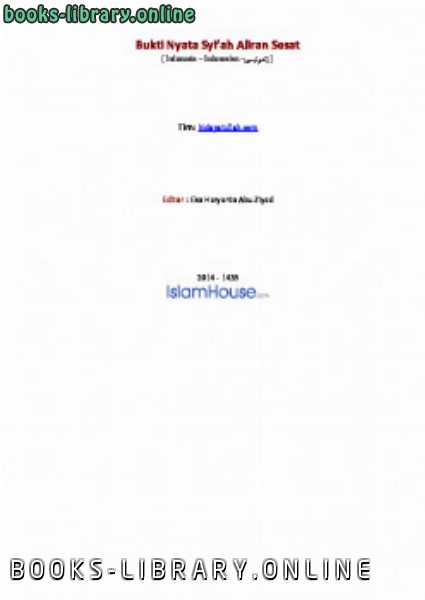
Bukti Nyata Syi rsquo ah Aliran Sesat PDF
قراءة و تحميل كتاب Bukti Nyata Syi rsquo ah Aliran Sesat PDF مجانا
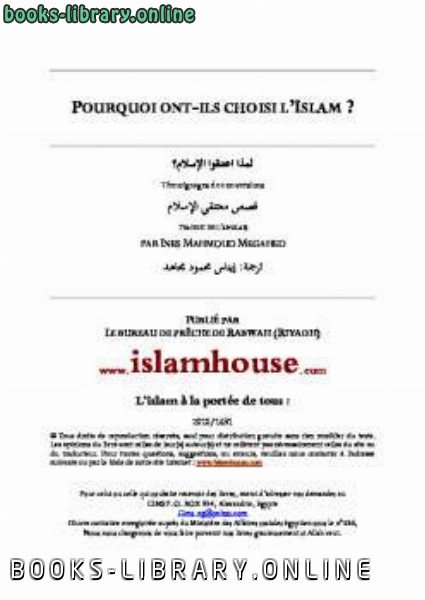
Pourquoi ont ils choisi l rsquo Islam PDF
قراءة و تحميل كتاب Pourquoi ont ils choisi l rsquo Islam PDF مجانا
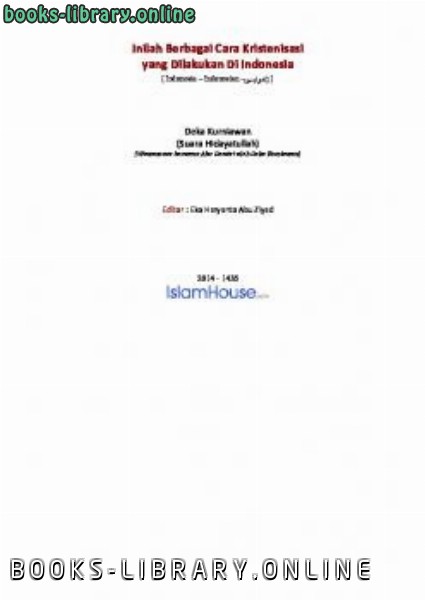
Inilah Berbagai Cara Kristenisasi Yang Dilakukan Di Indonesia PDF
قراءة و تحميل كتاب Inilah Berbagai Cara Kristenisasi Yang Dilakukan Di Indonesia PDF مجانا
